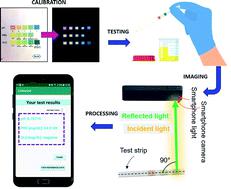当前位置:
X-MOL 学术
›
Anal. Methods
›
论文详情
Our official English website, www.x-mol.net, welcomes your feedback! (Note: you will need to create a separate account there.)
Smartphone-based colorimetric detection system for portable health tracking
Analytical Methods ( IF 3.1 ) Pub Date : 2021-09-08 , DOI: 10.1039/d1ay01209f Samira Balbach 1 , Nan Jiang 2 , Rosalia Moreddu 3 , Xingchen Dong 1, 4 , Wolfgang Kurz 1 , Congyan Wang 1 , Jie Dong 1 , Yixia Yin 5 , Haider Butt 6 , Martin Brischwein 7 , Oliver Hayden 7 , Martin Jakobi 1 , Savas Tasoglu 8 , Alexander W Koch 1 , Ali K Yetisen 4
Analytical Methods ( IF 3.1 ) Pub Date : 2021-09-08 , DOI: 10.1039/d1ay01209f Samira Balbach 1 , Nan Jiang 2 , Rosalia Moreddu 3 , Xingchen Dong 1, 4 , Wolfgang Kurz 1 , Congyan Wang 1 , Jie Dong 1 , Yixia Yin 5 , Haider Butt 6 , Martin Brischwein 7 , Oliver Hayden 7 , Martin Jakobi 1 , Savas Tasoglu 8 , Alexander W Koch 1 , Ali K Yetisen 4
Affiliation

|
Colorimetric tests for at-home health monitoring became popular 50 years ago with the advent of the urinalysis test strips, due to their reduced costs, practicality, and ease of operation. However, developing digital systems that can interface these sensors in an efficient manner remains a challenge. Efforts have been put towards the development of portable optical readout systems, such as smartphones. However, their use in daily settings is still limited by their error-prone nature associated to optical noise from the ambient lighting, and their low sensitivity. Here, a smartphone application (Colourine) to readout colorimetric signals was developed on Android OS and tested on commercial urinalysis test strips for pH, proteins, and glucose detection. The novelty of this approach includes two features: a pre-calibration step where the user is asked to take a photo of the commercial reference chart, and a CIE-RGB-to-HSV color space transformation of the acquired data. These two elements allow the background noise given by environmental lighting to be minimized. The sensors were characterized in the ambient light range 100–400 lx, yielding a reliable output. Readouts were taken from urine strips in buffer solutions of pH (5.0–9.0 units), proteins (0–500 mg dL−1) and glucose (0–1000 mg dL−1), yielding a limit of detection (LOD) of 0.13 units (pH), 7.5 mg dL−1 (proteins) and 22 mg dL−1 (glucose), resulting in an average LOD decrease by about 2.8 fold compared to the visual method.
中文翻译:

用于便携式健康跟踪的基于智能手机的比色检测系统
50 年前,随着尿液分析试纸的出现,用于家庭健康监测的比色测试变得流行,因为它们降低了成本、实用性和易于操作。然而,开发能够以有效方式连接这些传感器的数字系统仍然是一个挑战。已经致力于开发便携式光学读出系统,例如智能手机。然而,它们在日常环境中的使用仍然受到与环境照明的光学噪声相关的容易出错的性质以及它们的低灵敏度的限制。在这里,在 Android 操作系统上开发了一个用于读取比色信号的智能手机应用程序 (Colourine),并在商业尿液分析试纸上进行了测试,用于检测 pH、蛋白质和葡萄糖。这种方法的新颖之处包括两个特点:一个预校准步骤,要求用户拍摄商业参考图表的照片,以及对获取的数据进行 CIE-RGB 到 HSV 色彩空间转换。这两个元素使环境照明产生的背景噪音最小化。传感器在 100-400 lx 的环境光范围内进行表征,产生可靠的输出。读数取自在 pH(5.0-9.0 单位)、蛋白质(0-500 mg dL-1 ) 和葡萄糖 (0–1000 mg dL -1 ),检测限 (LOD) 为 0.13 个单位 (pH)、7.5 mg dL -1(蛋白质)和 22 mg dL -1(葡萄糖),导致与视觉方法相比,平均 LOD 降低了约 2.8 倍。
更新日期:2021-09-08
中文翻译:

用于便携式健康跟踪的基于智能手机的比色检测系统
50 年前,随着尿液分析试纸的出现,用于家庭健康监测的比色测试变得流行,因为它们降低了成本、实用性和易于操作。然而,开发能够以有效方式连接这些传感器的数字系统仍然是一个挑战。已经致力于开发便携式光学读出系统,例如智能手机。然而,它们在日常环境中的使用仍然受到与环境照明的光学噪声相关的容易出错的性质以及它们的低灵敏度的限制。在这里,在 Android 操作系统上开发了一个用于读取比色信号的智能手机应用程序 (Colourine),并在商业尿液分析试纸上进行了测试,用于检测 pH、蛋白质和葡萄糖。这种方法的新颖之处包括两个特点:一个预校准步骤,要求用户拍摄商业参考图表的照片,以及对获取的数据进行 CIE-RGB 到 HSV 色彩空间转换。这两个元素使环境照明产生的背景噪音最小化。传感器在 100-400 lx 的环境光范围内进行表征,产生可靠的输出。读数取自在 pH(5.0-9.0 单位)、蛋白质(0-500 mg dL-1 ) 和葡萄糖 (0–1000 mg dL -1 ),检测限 (LOD) 为 0.13 个单位 (pH)、7.5 mg dL -1(蛋白质)和 22 mg dL -1(葡萄糖),导致与视觉方法相比,平均 LOD 降低了约 2.8 倍。



























 京公网安备 11010802027423号
京公网安备 11010802027423号